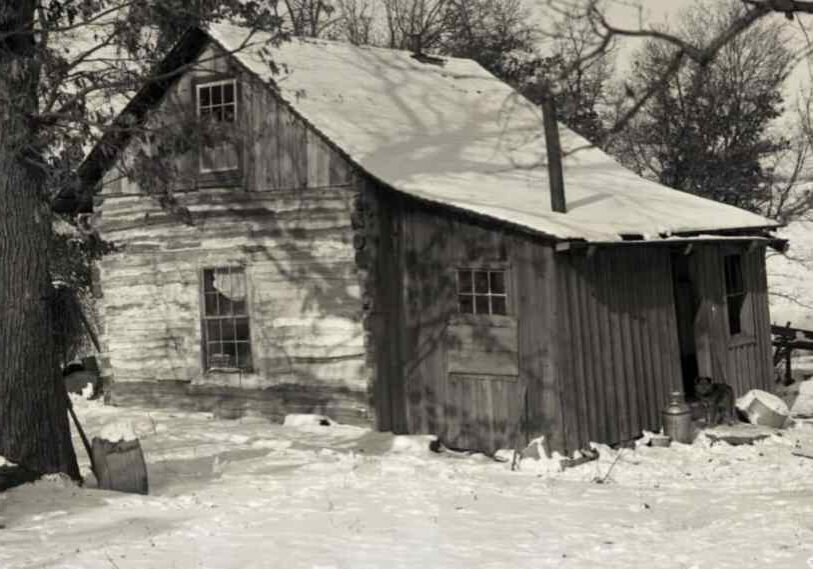Woolly Mammoths Once Roamed our Driftless Area
Evidence of prehistoric woolly mammoths on exhibit

MOWER COUNTY – Just beyond the farthest reaches of southeastern Minnesota’s Root River, nearly smack-dab in the middle of the Cedar River watershed (near Austin, to be specific), a discovery was made over a hundred years ago that took many by surprise: a five-pound, seven-inch-high petrified tooth.
The tooth, it turned out, belonged to a woolly mammoth that called this area “home” thousands of years ago. The last woolly mammoths survived in North America until about 4,000 years ago, though most went extinct another 6,000 years earlier, according to National Geographic.

At a whopping seven inches high, six inches across, four inches deep and weighing 5 ¼ pounds, this woolly mammoth tooth was discovered in 1916 near the Mower County fairgrounds in Austin, Minn. (Photo submitted by Cedar River Watershed District)
Discovered in 1916, the tooth was unearthed in what was called “Galloway’s pit,” where crews had been removing thousands of loads of building sand for projects around town.
“It is not a gold nugget, but it was a find worthwhile,” the Austin Daily Herald wrote Aug. 26, 1916, noting John Galloway’s relic was in “almost perfect preservation.”
This prehistoric fossil now is on display at the Austin Public Library. “The library is excited to host this piece of local prehistoric history,” said Julie Clinefelter, director of the Austin Public Library.

The story of woolly mammoths and their presence in Southeast Minnesota is told through an exhibit currently on view at the Austin Public Library – including a mammoth tooth unearthed locally, thanks to the University of Minnesota’s Bell Museum which agreed to loan the prehistoric fossil for the local exhibit. (Photo submitted by Cedar River Watershed District)
It’s on exhibit, through December, in partnership with the Cedar River Watershed District, Austin Area Foundation and the University of Minnesota’s Bell Museum (St. Paul), which owns the tooth.
Secured in a display box, the tooth is featured along with posters showing the Bell Museum’s woolly mammoth replica and Herald articles from 1916 and 1920 about mammoth tooth discoveries in the area.
Its discovery
In August 1916, a crew working in John Galloway’s pit uncovered the mammoth tooth now on view at the library. It measured 7 inches high, 6 inches across and 4 inches deep, weighing 5.25 pounds.
At that time, Minnesota had 12 counties with similar reports of people finding mammoth teeth and bones. According to the Science Museum of Minnesota, mammoths are well-represented in Minnesota as they roamed the tundra-like landscape between glacier events and in the glacier-free “Driftless Area.”

This 1896 map shows the Galloway farm along the edge of the City of Austin, Minn., where a woolly mammoth tooth was discovered in 1916. (Photo submitted by Cedar River Watershed District)
Galloway took the fossil to a local dentist who declared it as the “last molar of the upper right jaw of a mastodon,” which today is known as a different species than a woolly mammoth.
“Imagination builds the old relic into a tooth. It also constructs the monster who owned the molar and gnashed such teeth in rage,” the Herald wrote.
“How or when he walked through these peaceful plains is a mystery. Where the rest of the mammoth body lies and why a tooth fell in the Galloway sand pit are all questions no one will answer.”
Not the only one unearthed
Four years later, a downtown store was showing off another woolly mammoth tooth in its display window.
A dredger had unearthed this tooth from the Cedar River on June 12, 1920, from the bottom of the Cedar River at Austin Mill Pond when crews were creating Horace Austin State Park out of what was mostly swampland. (Three months later, the dredger found half of another mammoth tooth.)
The dredger’s suction pipe had worked its way down 20 feet into sand before out of the exit pipe came a fossil tooth. News spread across the region. Books, brochures and other artifacts about prehistoric woolly mammoths that once lived in the Drifltess Area are included in this exhibit at the Austin Public Library through December. (Photo submitted by Cedar River Watershed District) Weighing some 6 to 8 tons, woolly mammoths are the ice ages’ best-known mammals, according to the Smithsonian Institute. Woolly mammoths became extinct due to a shifting climate, changing food sources and humans emerging as new predators. During the Pleistocene ice age, woolly mammoths stood about 10 feet tall and had 12-foot-long, sloping tusks weighing about 200 pounds, the U.S. National Park Service says. To preserve warmth on the icy tundra, woolly mammoths had a tuft of hair on top of their head and a shaggy layer of insulated hair. Despite an intimidating look, woolly mammoths mostly ate plants with a shorter, split trunk that helped hold vegetation. 
By the numbers
This tooth weighed 7 pounds, 9 ounces and measured 6 inches from the grinding surface to its root ends, 4 inches wide and 8 inches long. The tooth’s whereabouts after being displayed in 1920 are unknown.

Newspapers headlined woolly mammoth stories that captured readers’ attention in the early 20th century. (Submitted by Cedar River Watershed District)
In 1996, the skull and 8-foot-long tusks of a 20-something male mammoth were found on the William Lyle farm near Albert Lea Lake. These fossils now reside at the Minnesota Science Museum.
Story edited for Root River Current by John Gaddo.
Based in St. Paul, the Bell Museum has loaned the Galloway tooth to the Austin Public Library at no charge after getting a request from the local partnership. The museum was given the tooth in 2011 when one of Galloway’s grandchildren donated the relic. Galloway’s son Cedric had taken the tooth with him in 1937 when he moved to California. “We are grateful to the Bell Museum’s generosity in allowing us to share the amazing, prehistoric relic with the community and for the Austin Area Foundation’s grant to enhance its exhibit,” said Tim Ruzek, outreach coordinator for the Cedar River Watershed District.







